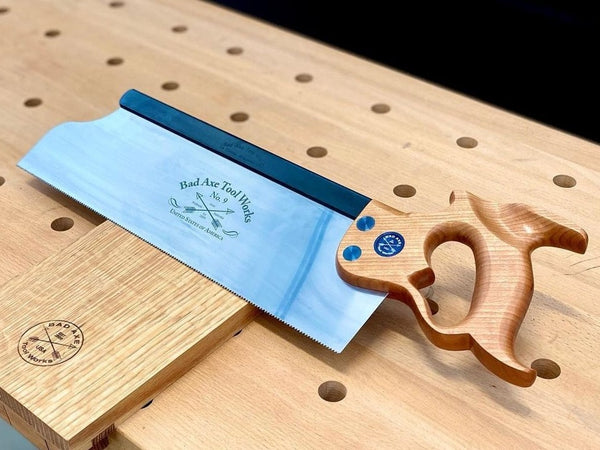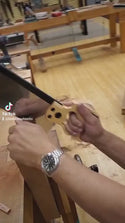Plate & Filing:
The rip-cut filing pattern is optimized for cutting along the grain.
The crosscut filing pattern is expertly filed for cutting across the grain.
The hybrid filing is a good balance in between both rip and cross-cut filing.
Our saw plates are crafted from premium Swedish Spring Steel, tempered to a hardness of HRC 48-52 for exceptional durability and performance.
Sawbacks:
Delve into the craftsmanship behind our traditional folded sawbacks, a hallmark of excellence that sets Bad Axe's saws apart from the rest. Our folded backs embody a heritage of detailed artistry and functionality.
Crafted through time-honored techniques, our folded backs undergo a precise process, resulting in a seamless, robust construction. This method not only enhances the structural integrity of the saw but also allows for dynamic adjustments and retensioning of the toothline, crucial for maintaining optimal cutting performance over time. Watch this short video on Retensioning to see how it’s done.
In contrast, milled brass static backs lack the versatility and resilience of our traditional folded backs. Their uniformity limits the ability to adjust tension, rendering them prone to premature wear, especially under rigorous use.
Sawback Coating Options -
Each Bad Axe sawback begins with cold-rolled steel, valued for its strength and durability. We offer three premium coating options:
-
Black-Oxide: A sleek, matte finish that provides basic protection against rust.
-
Nickel: A mirror bright finish that not only adds a refined appearance but also offers enhanced corrosion resistance, ensuring long-term durability.
-
Titanium Nitride: A striking brass-toned finish renowned for its exceptional hardness, and superior protection against corrosion.
Handle:
Each Bad Axe handle is meticulously crafted from full-heart quartersawn stock in a selection of premium North American hardwoods including Cherry, White Oak, Hard Maple, and Walnut.
Why choose quartersawn wood? Despite being the priciest option, quartersawn stock offers unparalleled stability, minimizing the effects of seasonal wood movement that can compromise the accuracy of the saw plate alignment. At Bad Axe, we prioritize the use of quartersawn wood to ensure the longevity and reliability of our handles.
Furthermore, we are committed to sustainability and environmental responsibility. All our handle stock is sourced from a trusted family-owned business known for their sustainable lumber harvesting practices. This partnership, established from the inception of Bad Axe, underscores our dedication to supporting North American hardwoods and promoting eco-conscious manufacturing processes.
Handle Finish -
All handles are dipped in natural Watco Danish Oil, except for Walnut handles, which are finished with black walnut Watco Oil. Each handle is then polished on a Tripoli buffing wheel and sealed with a layer of carnauba wax for a smooth, durable finish.
Fasteners:
We offer four fastener options to complement your saw: Brass, for a classic, polished look; or Black, Nickel, and Niter-Blue, which are steel fasteners coated for enhanced durability. All fasteners feature a slotted nut design, allowing you to easily use a flathead screwdriver for easy adjustments.



























